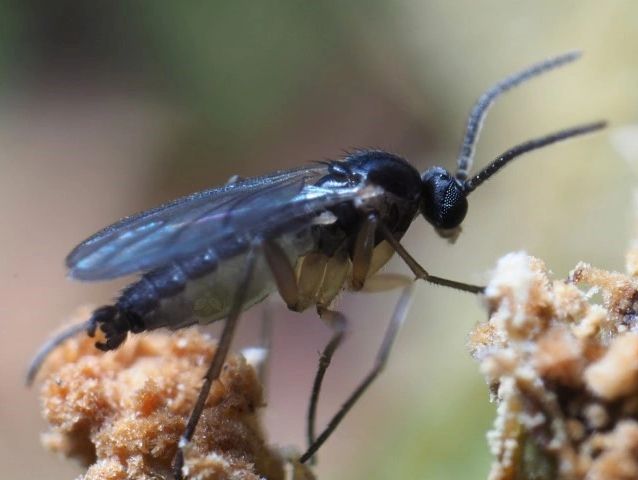
BIOLOGICAL CONTROL AGENTS FOR FUNGUS GNATS
We currently offer two predators (a predatory mite and a predatory beetle) and two species of parasitic nematodes for fungus gnat management.
Please note that the nematodes must be applied in water to the growing medium.
PLEASE CONTACT US FOR CURRENT PRICES
Fungus gnat predators
Stratiolaelaps scimitus (formerly known as Hypoaspis miles)
Stratiolaelaps scimitus is a relatively large, soil-dwelling predatory mite, the mature females of which can be up to 1 mm long; males are smaller. Adults are a pale beige/brown, with a darker 'dorsal shield' that tapers towards the rear and covers most of the upper surface (as pictured); the immature stages are paler in color.
All life stages of this mite are found mainly in the top 1–2 cm of soil or growing media; only very rarely are they found on above-ground parts of plants. The minute white oval eggs are laid on the soil surface and hatch into six-legged larvae that subsequently pass through two eight-legged nymphal stages. Adults and nymphs will feed on the larvae of fungus gnats, as well as on various other small soil-dwelling mites and insects (including the young larvae of various other flies, the pupae of thrips species that pupate in the soil (e.g. western flower thrips (Frankliniella occidentalis), some nematode species, springtails, etc.).
Stratiolaelaps scimitus can survive in temperatures ranging from 12 to 30 °C (54–86 °F), but activity drops rapidly when soil temperatures fall below 15 °C (59 °F). The optimal temperatures for population growth are 20–25 °C (68–77°F). At 20 °C, the life-cycle (egg to adult) is completed in approximately 18 days. Adult longevity depends on both temperature and prey availability, but this species is capable of surviving for approximately 6–8 weeks in the absence of prey (as long as water is present) and longer with adequate nutrition.
Stratiolaelaps scimitus is available in various pack sizes ranging from 12,500 to 125,000 (mixed life stages).

Dalotia coriaria (formerly known as Atheta coriaria) (Rove beetle)
Adults of Dalotia coriaria are small, slender rove beetles dark brown/black in color and approximately 3–4 mm long. Both adults and larvae are generalist predators of soil-dwelling pests, including the immature stages of fungus gnats (Sciaridae) and shore flies (Ephydridae), as well as thrips pupae.
As in other beetles, the hind wings are folded under the modified forewings (elytra) when not in use, but in rove beetles, the very short elytra leave most of the abdomen exposed. This allows them to curve their abdomen upwards when disturbed—a behavior that is characteristic of this family.
Dalotia coriaria adults fly actively (mainly at night) and can disperse readily. Nevertheless, the adults are usually found in or on the growing medium, adapting well to a variety of substrates (including peat mixes and coir).
There are three larval stages, the first of which is whitish in color; subsequent instars are somewhat darker, with the last larval stage being yellowish/pale tan. When monitoring, gently disturbing the top 1–2 cm of soil can reveal their presence: all larval stages move rapidly and readily enter cracks and crevices in the soil. Pupation occurs in the growing medium.
Optimum temperatures for this species appear to lie between 20 and 25 °C (68–77 °F); at 21 °C (70 °F), the life-cycle takes approximately 18 days. High temperatures (approaching 32 °C/90 °F)) may reduce the survival of immature stages. Estimates of adult longevity vary from approximately 3 weeks to 6–8 weeks, depending on environmental conditions. This species does not seem to enter diapause under most greenhouse conditions.
Dalotia coriaria is available in pack sizes ranging from 500 to 5000 (mixed life stages).

Entomopathogenic nematodes
Entomopathogenic nematodes are microscopic roundworms that parasitize soil-dwelling pests, including the larval stages of fungus gnats (Sciaridae) and shore flies (Ephydridae). They are not harmful to plants. Different species differ in their host range, environmental tolerances, and in the distance they will move to find hosts.
Steinernema feltiae and Steinernema carpocapsae
Steinernema carpocapsae is relatively sedentary and tends to remain near the soil surface to 'ambush' its hosts, whereas S. feltiae will search more actively through the substrate. Nevertheless, S. carpocapsae has been found parasitizing hosts at some depth in the soil, and it has been suggested that larger roots may serve as 'pathways' that facilitates its movement through the soil.
Entomopathogenic nematodes are supplied as infective juveniles, which are usually applied as a soil drench. On contacting a suitable host, Steinernema juveniles enter the body cavity through the mouth, anus, or spiracles; once inside, they release symbiotic bacteria that multiply rapidly and usually kill the host within 1–3 days. The nematodes feed, mature and reproduce within the dead host until the latter eventually ruptures, releasing thousands of new infective juveniles to continue the process. Depending on environmental conditions and the host species, this may take 2-3 weeks.
Steinernema carpocapsae is most effective at soil temperatures between 22–28 °C (72–82 °F); S. feltiae can remain infective at soil temperatures as low as 10 °C (50 °F), but development is faster at higher temperatures (up to 30 °C/86 °F).

Copyright © 2022 Sierra Biological Inc. - All Rights Reserved.
Powered by GoDaddy
